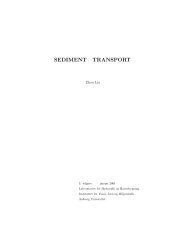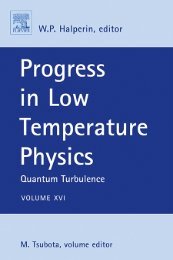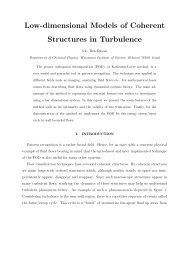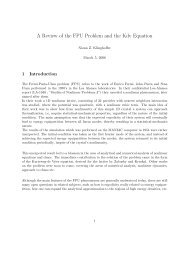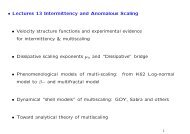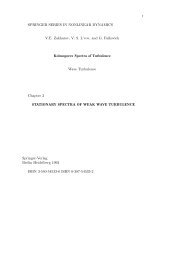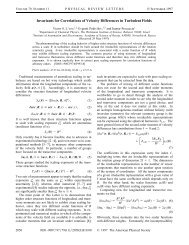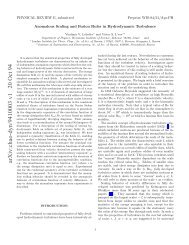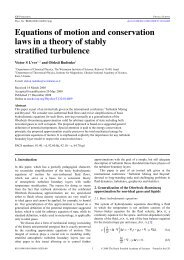Phys. Rev. A - Victor S. L'vov Home-page - Weizmann Institute of ...
Phys. Rev. A - Victor S. L'vov Home-page - Weizmann Institute of ...
Phys. Rev. A - Victor S. L'vov Home-page - Weizmann Institute of ...
You also want an ePaper? Increase the reach of your titles
YUMPU automatically turns print PDFs into web optimized ePapers that Google loves.
4766 VICTOR L'VOV AND GREGORY FALKOVICH - 46<br />
+ waD /am + . . . into (20) and integrate the additional<br />
terms arising in (21) in the same manner. Finally, we ob-<br />
tain the following corrections to (23):<br />
Here a, and a, are some dimensionless constants, x being<br />
the dynamic scaling exponent (for the Kolmogorov solution,<br />
y = y, x = f ). For multifractal subsets with an arbitrary<br />
h, one could obtain x = 1 - h, since the typical frequency<br />
scales with 1 as 6v(l)/l. We shall demonstrate<br />
below that h 5 1, so x > 0. The account <strong>of</strong> the frequency<br />
dependence gives indeed the small corrections in each order<br />
<strong>of</strong> the expansion in k /q. Therefore, we shall use (23)<br />
in the further calculations.<br />
It is important to emphasize here that 6 functions <strong>of</strong><br />
the frequencies in (20) are the same in both terms arising<br />
in (20) after substituting the vertex V. This leads to the<br />
absence <strong>of</strong> a term proportional to kXF(k) in the expansion<br />
(23). So the main term in the asymptotic expansion<br />
<strong>of</strong> triple-correlation function (24) is a k ' -Y@l( q )/q. The<br />
total scaling exponent <strong>of</strong> the triple-correlation function is<br />
y, =7 according to (14). The scaling exponent <strong>of</strong> @,,,(q)<br />
may be thus expressed in terms <strong>of</strong> the scaling exponent y<br />
<strong>of</strong> the double correlator<br />
Let us allow a small digression. It is interesting to<br />
compare z, which one would obtain in the direct-<br />
interaction approximation [7] for the triple-correlation<br />
function, with the above correct answer. In that approxi-<br />
mation (see the Appendix for details)<br />
Using (201, one has in the same way the estimation for<br />
functions @:<br />
Due to the scaling relation 2x +y = 5 [8,11], the same result<br />
for z, could be easily obtained in any (finite) order <strong>of</strong><br />
diagrammatic perturbation theory or under the assumption<br />
that the dynamic vertex V is not renormalized. The<br />
value oCzo coincides with the correct result z =7-y only<br />
on the Kolmogorov solution x = f, y = y. For example,<br />
in the multifractality approach, y > 9, which reflects the<br />
renormalization <strong>of</strong> the vertices for a multifractal turbulence.<br />
We do not know now how it occurs, but we<br />
know the total exponent <strong>of</strong> the triple correlators. So, in<br />
order to find the scaling exponent z <strong>of</strong> large wave vectors<br />
in the triple-velocity correlator, it is necessary to take<br />
into account the entire diagrammatic series which leads<br />
to a renormalization <strong>of</strong> the vertices.<br />
The difference between the initial result <strong>of</strong> Kraichnan<br />
[7] and the present approach is due to the fact that the<br />
direct-interaction approximation is an uncontrolled pro-<br />
cedure. On the contrary, we shall analyze in the Appen-<br />
dix the whole series, find the main contribution into the<br />
triple correlator for q >>k, and prove that the neglected<br />
terms are small by parameter (k/q)11'3. Our approach is<br />
thus controlled with a really small parameter. We get a<br />
result different from that <strong>of</strong> [7]: interactions with distant<br />
scales are counterbalanced for a real spectrum with a<br />
constant energy flux (whatever 4, it has), not only for the<br />
Kolmogorov solution as in the direct-interaction approxi-<br />
mation.<br />
Now let us briefly explain the physical meaning <strong>of</strong> the<br />
final expressions (23) and (24). The triple-correlation<br />
function (11) with one wave number being small in com-<br />
parison with two others corresponds to the triple-<br />
correlation function (26) <strong>of</strong> velocity increments between<br />
three points in r space, with one distance being smaller<br />
than two others: r2,=r




